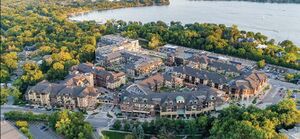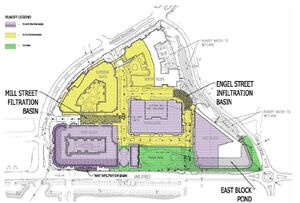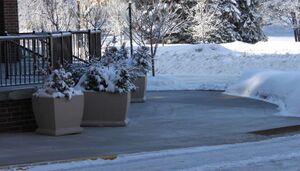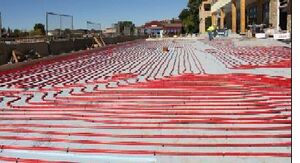
Difference between revisions of "Chloride reduction case study: The Promenade of Wayzata"
(Created page with "300px|thumb|alt=image of Promenade of Wayzata|<font size=3>Promenade of Wayzata</font size> File:Figure 02 - Design detail sho...") |
m |
||
| (3 intermediate revisions by the same user not shown) | |||
| Line 1: | Line 1: | ||
| + | [[File:General information page image.png|left|100px|alt=image]] | ||
[[File:Figure 01 - Promenade of Wayzata.JPG|300px|thumb|alt=image of Promenade of Wayzata|<font size=3>Promenade of Wayzata</font size>]] | [[File:Figure 01 - Promenade of Wayzata.JPG|300px|thumb|alt=image of Promenade of Wayzata|<font size=3>Promenade of Wayzata</font size>]] | ||
| − | |||
[[File:Figure 02 - Design detail showing location of water quality treatement features.JPG|300px|thumb|alt=image of water quality treatment features|<font size=3>water quality treatment features</font size>]] | [[File:Figure 02 - Design detail showing location of water quality treatement features.JPG|300px|thumb|alt=image of water quality treatment features|<font size=3>water quality treatment features</font size>]] | ||
| − | |||
[[File:Figure 03 - Winter image of sidewalk cleared of ice through use of hydronic snowmelt tubing.JPG|300px|thumb|alt=image of sidewalk cleared of ice through use of hydronic snowmelt tubing|<font size=3>sidewalk cleared of ice through use of hydronic snowmelt tubing</font size>]] | [[File:Figure 03 - Winter image of sidewalk cleared of ice through use of hydronic snowmelt tubing.JPG|300px|thumb|alt=image of sidewalk cleared of ice through use of hydronic snowmelt tubing|<font size=3>sidewalk cleared of ice through use of hydronic snowmelt tubing</font size>]] | ||
| − | |||
[[File:Figure 04 - image of hydronic snowmelt tubing application at Promenade of Wayzata.JPG|300px|thumb|alt=image of Image of hydronic snowmelt tubing application at Promenade of Wayzata|<font size=3>Image of hydronic snowmelt tubing application at Promenade of Wayzata</font size>]] | [[File:Figure 04 - image of hydronic snowmelt tubing application at Promenade of Wayzata.JPG|300px|thumb|alt=image of Image of hydronic snowmelt tubing application at Promenade of Wayzata|<font size=3>Image of hydronic snowmelt tubing application at Promenade of Wayzata</font size>]] | ||
| − | Increasing chloride concentrations have been observed in groundwater, streams, and lakes throughout the state of Minnesota. The major source of chloride discharge to Minnesota waterbodies is associated with the use of deicing salt products to control ice on road surfaces, parking lots, and sidewalks. Secondary sources of chloride include the use of salt in water softeners and chlorides associated with fertilizer and dust suppressants. Chloride can degrade surface and groundwater sources of drinking water and is a suspected stressor to many forms of freshwater aquatic life. Additionally, chloride can degrade ecosystem health by negatively impacting plant communities and cause structural damage to infrastructure such as bridges and road surfaces. Chloride is a conservative (non-reactive) pollutant and can only be removed through water quality treatment practices such as reverse osmosis, which is prohibitively expensive. For this reason, source reduction (i.e., limiting and reducing chloride use and application) is critical to controlling chloride concentration in Minnesota waters. | + | Increasing chloride concentrations have been observed in groundwater, streams, and lakes throughout the state of Minnesota. The major source of chloride discharge to Minnesota waterbodies is associated with the use of <span title="Deicing typically refers to removal of salt from impervious surfaces, such as roads, driveways, parking lots, and sidewalks. Chemicals, most commonly sodium chloride, are often used for deicing."> '''deicing'''</span> salt products to [https://stormwater.pca.state.mn.us/index.php/Road_salt,_smart_salting_and_winter_maintenance control ice] on road surfaces, parking lots, and sidewalks. Secondary sources of chloride include the use of salt in water softeners and chlorides associated with fertilizer and dust suppressants. Chloride can degrade surface and groundwater sources of drinking water and is a suspected stressor to many forms of freshwater <span title="A habitat with water. It includes areas that are permanently covered by water and surrounding areas that are occasionally covered by water. Estuaries, rivers, and marshes are examples of aquatic habitats."> '''aquatic life'''</span>. Additionally, chloride can degrade ecosystem health by negatively impacting plant communities and cause structural damage to infrastructure such as bridges and road surfaces. Chloride is a conservative (non-reactive) pollutant and can only be removed through water quality treatment practices such as reverse osmosis, which is prohibitively expensive. For this reason, source reduction (i.e., limiting and reducing chloride use and application) is critical to controlling chloride concentration in Minnesota waters. |
| − | The Promenade of Wayzata, completed in 2018, is reportedly the largest redevelopment project completed in the City of Wayzata’s history. The Promenade, located near the north shore of Wayzata Bay off of Lake Street and Superior Boulevard, is a multi-use redevelopment project replacing a shopping mall constructed in the 1960s. The shopping mall was constructed over a 14-acre wetland before Wetland Conservation Act (WCA) regulations were in place. A major goal of the Promenade redevelopment project was to return critical functions of the impacted wetland area through the use of innovative stormwater management and water quality treatment techniques, including under-street infiltration and filtration, a large stormwater pond located underneath one of the buildings, green roofs, and a massive network of heated boulevards to eliminate the need for chloride-containing deicing products. | + | The [https://www.thepromenadeofwayzata.com/ Promenade of Wayzata], completed in 2018, is reportedly the largest redevelopment project completed in the City of Wayzata’s history. The Promenade, located near the north shore of Wayzata Bay off of Lake Street and Superior Boulevard, is a multi-use redevelopment project replacing a shopping mall constructed in the 1960s. The shopping mall was constructed over a 14-acre wetland before [http://bwsr.state.mn.us/wca-program-guidance-and-information Wetland Conservation Act] (WCA) regulations were in place. A major goal of the Promenade redevelopment project was to return critical functions of the impacted wetland area through the use of innovative stormwater management and water quality treatment techniques, including under-street <span title="Infiltration Best Management Practices (BMPs) treat urban stormwater runoff as it flows through a filtering medium and into underlying soil, where it may eventually percolate into groundwater. The filtering media is typically coarse-textured and may contain organic material, as in the case of bioinfiltration BMPs."> [https://stormwater.pca.state.mn.us/index.php?title=Stormwater_infiltration_Best_Management_Practices '''infiltration''']</span> and <span title="Filtration Best Management Practices (BMPs) treat urban stormwater runoff as it flows through a filtering medium, such as sand or an organic material. They are generally used on small drainage areas (5 acres or less) and are primarily designed for pollutant removal. They are effective at removing total suspended solids (TSS), particulate phosphorus, metals, and most organics. They are less effective for soluble pollutants such as dissolved phosphorus, chloride, and nitrate."> [https://stormwater.pca.state.mn.us/index.php?title=Filtration '''filtration''']</span>, a large stormwater <span title="A stormwater retention basin that includes a combination of permanent pool storage and extended detention storage above the permanent pool to provide additional water quality or rate control"> [https://stormwater.pca.state.mn.us/index.php?title=Stormwater_ponds '''wet pond''']</span> located underneath one of the buildings, <span title="Green roofs consist of a series of layers that create an environment suitable for plant growth without damaging the underlying roof system. Green roofs create green space for public benefit, energy efficiency, and stormwater retention/ detention."> '''[https://stormwater.pca.state.mn.us/index.php?title=Green_roofs green roofs]'''</span>, and a massive network of heated boulevards to eliminate the need for chloride-containing deicing products. |
| − | The heated boulevards at the Promenade of Wayzata are accomplished through the use of over 80 miles of hydronic snowmelt tubing located under 5 acres of streets and sidewalks through the redevelopment site. The hydronic snowmelt tubing circulates heated water and propylene glycol (non-toxic anti-freeze) under paved surfaces, raising pavement surface temperature to melt snow and prevent the formation of ice. The former Wayzata Bay Shopping Center had nearly 8 acres of paved surfaces requiring deicing, which was accomplished primarily through the application of chloride-containing rock salt. It is estimated the former site applied nearly 32 tons of rock salt each winter season. Stormwater runoff from the site discharges directly to Wayzata Bay and Minnehaha Creek, which was listed on the Minnesota 2020 Impaired Waters List for chloride impairment. The heated boulevards have eliminated the need for rock salt application where applied, significantly reducing discharge of chloride to Wayzata Bay. In addition, the dry sidewalks and streets reduce accidents and liability from slips on icy surfaces, as well as helping businesses track less salt and moisture into the building thereby prolonging the life of interior surfacing (e.g., carpets). Finally, the elimination of mechanical snow removal reduces wear and tear on the sidewalks and streets themselves, saving maintenance costs. | + | The heated boulevards at the Promenade of Wayzata are accomplished through the use of over 80 miles of hydronic snowmelt tubing located under 5 acres of streets and sidewalks through the redevelopment site. The hydronic snowmelt tubing circulates heated water and propylene glycol (non-toxic anti-freeze) under paved surfaces, raising pavement surface temperature to melt snow and prevent the formation of ice. The former Wayzata Bay Shopping Center had nearly 8 acres of paved surfaces requiring deicing, which was accomplished primarily through the application of chloride-containing rock salt. It is estimated the former site applied nearly 32 tons of rock salt each winter season. Stormwater runoff from the site discharges directly to Wayzata Bay and Minnehaha Creek, which was listed on the Minnesota 2020 <span title="Impaired waters are bodies of water that exceed the limits of one or more parameters for surface water quality"> '''Impaired Waters'''</span> List for chloride impairment. The heated boulevards have eliminated the need for rock salt application where applied, significantly reducing discharge of chloride to Wayzata Bay. In addition, the dry sidewalks and streets reduce accidents and liability from slips on icy surfaces, as well as helping businesses track less salt and moisture into the building thereby prolonging the life of interior surfacing (e.g., carpets). Finally, the elimination of mechanical snow removal reduces wear and tear on the sidewalks and streets themselves, saving maintenance costs. |
| − | Development of The Promenade of Wayzata was accomplished by The Wayzata Bay Redevelopment Company, an entity formed by Presbyterian Homes & Services. LHB, Inc. provided master planning, civil engineering, and landscape architecture services. A complete list of entities involved in the redevelopment project is provided, below. An LHB, Inc. project engineer cited that one of the largest challenges posed by this redevelopment project from the perspective of stormwater management was the poor underlying soils and | + | Development of The Promenade of Wayzata was accomplished by The Wayzata Bay Redevelopment Company, an entity formed by Presbyterian Homes & Services. LHB, Inc. provided master planning, civil engineering, and landscape architecture services. A complete list of entities involved in the redevelopment project is provided, below. An LHB, Inc. project engineer cited that one of the largest challenges posed by this redevelopment project from the perspective of stormwater management was the poor underlying soils and <span title="Shallow groundwater is a condition where the seasonal high groundwater table, or saturated soil, is less than 3 feet from the land surface. There is a large portion of the state (more than 50 percent) where the seasonal high water table is located less than 3 feet from the surface."> [https://stormwater.pca.state.mn.us/index.php?title=Shallow_groundwater '''Shallow water table''']</span>, requiring innovative design and BMP implementation within and underneath paved surfaces and on roof surfaces. A key lesson learned related to the implementation of storm water runoff reduction practices was the importance of performing thorough [https://stormwater.pca.state.mn.us/index.php?title=Information_on_soil soil and hydrologic investigation]. Soil quality for infiltration varied widely across the site. For this reason, more borings than anticipated were needed to design storm water volume control practices. |
For more information related to The Promenade of Wayzata redevelopment project, contact Jim Tiggelaar, PE, CCS, LEED AP, Senior Project Manager at LHB, Inc.: jim.tiggelaar@LHBcorp.com | For more information related to The Promenade of Wayzata redevelopment project, contact Jim Tiggelaar, PE, CCS, LEED AP, Senior Project Manager at LHB, Inc.: jim.tiggelaar@LHBcorp.com | ||
| Line 26: | Line 24: | ||
*Mechanical-electrical-plumbing (MEP) engineering, geothermal, and hydronic snowmelt systems: Karges-Falconbridge, Inc. | *Mechanical-electrical-plumbing (MEP) engineering, geothermal, and hydronic snowmelt systems: Karges-Falconbridge, Inc. | ||
*Sub-developer for two of six blocks: Bohland Companies. | *Sub-developer for two of six blocks: Bohland Companies. | ||
| − | '''Project Cost''': $70M and 46,000 hours. | + | '''Project Cost''': $70M and 46,000 hours.<br> |
'''Quantitative Outcomes''': | '''Quantitative Outcomes''': | ||
*Chloride: estimated reduction of over 32 tons of rock salt per year. | *Chloride: estimated reduction of over 32 tons of rock salt per year. | ||
| Line 33: | Line 31: | ||
*TSS reduction: 5,500 pounds annual reduction (89% removal). | *TSS reduction: 5,500 pounds annual reduction (89% removal). | ||
*TP reduction: 19 pounds annual reduction (72% removal). | *TP reduction: 19 pounds annual reduction (72% removal). | ||
| + | |||
| + | [[Category:Level 2 - Pollutants/Chloride]] | ||
| + | [[Category:Level 2 - Case studies and examples/Case studies]] | ||
| + | [[Category:Level 2 - Management/Winter management]] | ||
Latest revision as of 15:23, 11 January 2023
Increasing chloride concentrations have been observed in groundwater, streams, and lakes throughout the state of Minnesota. The major source of chloride discharge to Minnesota waterbodies is associated with the use of deicing salt products to control ice on road surfaces, parking lots, and sidewalks. Secondary sources of chloride include the use of salt in water softeners and chlorides associated with fertilizer and dust suppressants. Chloride can degrade surface and groundwater sources of drinking water and is a suspected stressor to many forms of freshwater aquatic life. Additionally, chloride can degrade ecosystem health by negatively impacting plant communities and cause structural damage to infrastructure such as bridges and road surfaces. Chloride is a conservative (non-reactive) pollutant and can only be removed through water quality treatment practices such as reverse osmosis, which is prohibitively expensive. For this reason, source reduction (i.e., limiting and reducing chloride use and application) is critical to controlling chloride concentration in Minnesota waters.
The Promenade of Wayzata, completed in 2018, is reportedly the largest redevelopment project completed in the City of Wayzata’s history. The Promenade, located near the north shore of Wayzata Bay off of Lake Street and Superior Boulevard, is a multi-use redevelopment project replacing a shopping mall constructed in the 1960s. The shopping mall was constructed over a 14-acre wetland before Wetland Conservation Act (WCA) regulations were in place. A major goal of the Promenade redevelopment project was to return critical functions of the impacted wetland area through the use of innovative stormwater management and water quality treatment techniques, including under-street infiltration and filtration, a large stormwater wet pond located underneath one of the buildings, green roofs, and a massive network of heated boulevards to eliminate the need for chloride-containing deicing products.
The heated boulevards at the Promenade of Wayzata are accomplished through the use of over 80 miles of hydronic snowmelt tubing located under 5 acres of streets and sidewalks through the redevelopment site. The hydronic snowmelt tubing circulates heated water and propylene glycol (non-toxic anti-freeze) under paved surfaces, raising pavement surface temperature to melt snow and prevent the formation of ice. The former Wayzata Bay Shopping Center had nearly 8 acres of paved surfaces requiring deicing, which was accomplished primarily through the application of chloride-containing rock salt. It is estimated the former site applied nearly 32 tons of rock salt each winter season. Stormwater runoff from the site discharges directly to Wayzata Bay and Minnehaha Creek, which was listed on the Minnesota 2020 Impaired Waters List for chloride impairment. The heated boulevards have eliminated the need for rock salt application where applied, significantly reducing discharge of chloride to Wayzata Bay. In addition, the dry sidewalks and streets reduce accidents and liability from slips on icy surfaces, as well as helping businesses track less salt and moisture into the building thereby prolonging the life of interior surfacing (e.g., carpets). Finally, the elimination of mechanical snow removal reduces wear and tear on the sidewalks and streets themselves, saving maintenance costs.
Development of The Promenade of Wayzata was accomplished by The Wayzata Bay Redevelopment Company, an entity formed by Presbyterian Homes & Services. LHB, Inc. provided master planning, civil engineering, and landscape architecture services. A complete list of entities involved in the redevelopment project is provided, below. An LHB, Inc. project engineer cited that one of the largest challenges posed by this redevelopment project from the perspective of stormwater management was the poor underlying soils and Shallow water table, requiring innovative design and BMP implementation within and underneath paved surfaces and on roof surfaces. A key lesson learned related to the implementation of storm water runoff reduction practices was the importance of performing thorough soil and hydrologic investigation. Soil quality for infiltration varied widely across the site. For this reason, more borings than anticipated were needed to design storm water volume control practices.
For more information related to The Promenade of Wayzata redevelopment project, contact Jim Tiggelaar, PE, CCS, LEED AP, Senior Project Manager at LHB, Inc.: jim.tiggelaar@LHBcorp.com
Project Location: Wayzata, MN near the intersection of Lake Street and Wayzata Boulevard.
Completion Date: Phase 1: 2011 to 2014; Phase 2: 2013 to 2015, and Phase 3: 2015 to 2018.
Entities Involved:
- Master developer for four of six blocks: The Wayzata Bay Redevelopment Company, an entity formed by Presbyterian Homes & Services.
- Master planning, civil engineering, and landscape architecture services: LHB, Inc.
- Geotechnical, environmental, and construction testing services: American Engineering Testing, Inc.
- Structural engineering and infrastructure: Ericksen Roed & Associates.
- Mechanical-electrical-plumbing (MEP) engineering, geothermal, and hydronic snowmelt systems: Karges-Falconbridge, Inc.
- Sub-developer for two of six blocks: Bohland Companies.
Project Cost: $70M and 46,000 hours.
Quantitative Outcomes:
- Chloride: estimated reduction of over 32 tons of rock salt per year.
- Storm water flow rates: 60% decrease for 1-year storm, 40% decrease for 10-year storm, 31% decrease for 100-year storm.
- Storm water volume reduction: 32% decrease for 1-year storm, 20% decrease for 10-year storm, 15% decrease for 100-year storm. Approximately 4 million gallons infiltrated annually.
- TSS reduction: 5,500 pounds annual reduction (89% removal).
- TP reduction: 19 pounds annual reduction (72% removal).
This page was last edited on 11 January 2023, at 15:23.




